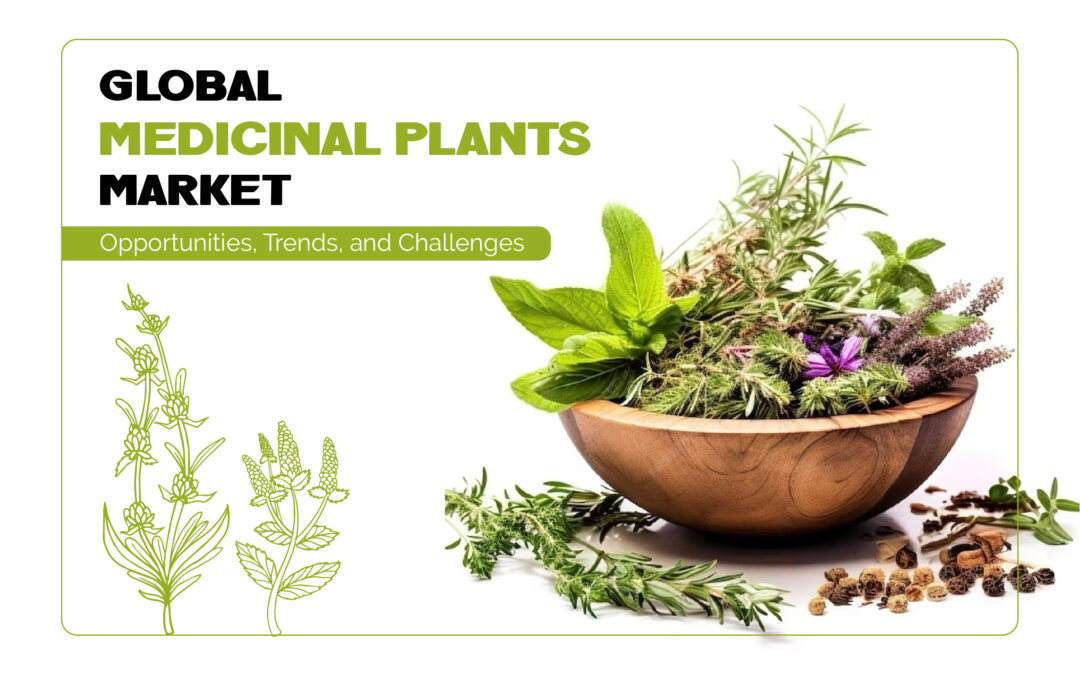The use of medicinal plants spans millennia, deeply rooted in cultural practices and traditional medicine systems across the globe. From Aloe Vera to Tulsi, these botanical wonders offer a plethora of therapeutic benefits, ranging from skin rejuvenation to stress relief. As the world grapples with the complexities of modern healthcare and an increasing preference for natural remedies, the demand for medicinal plants continues to surge. This demand is not only driven by consumers seeking holistic wellness solutions but also by pharmaceutical industries exploring botanicals as potential sources of novel drugs.
Here are a few medicinal plants listed:
Aloe Vera (Aloe barbadensis):
Known for its soothing properties, it’s used for treating burns, wounds, and skin irritation. Aloe vera is also used in various cosmetic products.
- Aloe Vera is cultivated in various regions worldwide, including countries with warm climates such as India, Mexico, South Africa, and the United States (particularly states like Texas, Arizona, and California).
- In India, Aloe Vera cultivation is widespread in states like Rajasthan, Gujarat, Andhra Pradesh, Tamil Nadu, and Karnataka.
Tulsi (Ocimum sanctum):
Tulsi, also known as Holy Basil, is a revered medicinal plant in Ayurveda. It has antimicrobial, anti-inflammatory, and adaptogenic properties. Tulsi is well-suited to the warm climate of Karnataka and can be cultivated in red soil areas.
- Tulsi is cultivated across India, particularly in regions with a tropical climate. States like Uttar Pradesh, Madhya Pradesh, Maharashtra, Gujarat, and Karnataka are major producers of Tulsi.
- It is also grown in other countries with similar climates, including Nepal, Sri Lanka, Thailand, and Indonesia.
Ashwagandha (Withania somnifera):
Ashwagandha is an adaptogenic herb used in traditional medicine to combat stress, improve stamina, and boost overall health. It prefers dry, sandy soil and thrives in warm climates, making it suitable for cultivation in red soil regions.
- Ashwagandha is predominantly cultivated in India, with major production in states like Madhya Pradesh, Rajasthan, Gujarat, Maharashtra, and Karnataka.
- It is also grown in other countries such as Nepal, China, and some parts of Africa and the Middle East.
Neem (Azadirachta indica):
Nimba trees can tolerate a wide range of soil types, including red soil. Neem is valued for its antibacterial, antifungal, and insecticidal properties. Various parts of the neem tree, such as leaves, bark, and seeds, are used in traditional medicine.
- Neem is native to the Indian subcontinent and widely cultivated throughout India, particularly in states like Tamil Nadu, Andhra Pradesh, Karnataka, Maharashtra, and Gujarat.
- It is also grown in other tropical regions such as parts of Africa, Southeast Asia, and Central America.
Senna (Cassia angustifolia):
Senna is a flowering plant known for its laxative properties. It grows well in warm, dry climates and can be cultivated in the red soil regions of Karnataka for medicinal purposes.
- Senna is primarily cultivated in countries with warm climates, including India, Sudan, Nigeria, Pakistan, and China.
- In India, Senna cultivation is prominent in states like Rajasthan, Gujarat, Maharashtra, Tamil Nadu, and Karnataka.
Ginseng (Panax ginseng):
Used in traditional medicine for its potential to improve energy levels, cognitive function, and immunity. Ginseng is also believed to have anti-inflammatory properties.
- Primarily cultivated in East Asia, particularly in China and Korea. It’s also grown in parts of North America, including the United States and Canada.
Lavender (Lavandula angustifolia):
Known for its calming effects, lavender is often used in aromatherapy to alleviate stress and anxiety. It’s also used in skincare products for its soothing properties.
- Cultivated in regions with well-drained soil and sunny climates, such as Provence in France, Bulgaria, England, and parts of the United States like California and Washington.
Echinacea (Echinacea purpurea):
Often used to boost the immune system and shorten the duration of the common cold or flu. Echinacea is available in various forms such as teas, supplements, and extracts.
- Mainly grown in the United States, particularly in states like Kansas, Nebraska, and South Dakota. It’s also cultivated in parts of Europe and Canada.
Turmeric (Curcuma longa):
Contains curcumin, a compound with potent anti-inflammatory and antioxidant properties. Turmeric is used in cooking, as a dietary supplement, and in traditional medicine for various health conditions.
- Turmeric is cultivated predominantly in India, with major production in states such as Tamil Nadu, Andhra Pradesh, Odisha, Karnataka, and West Bengal.
- Other significant producers include countries like Indonesia, Myanmar, Nigeria, Bangladesh, and Thailand.
Chamomile (Matricaria chamomilla):
Known for its calming and sleep-inducing effects, chamomile is often consumed as a tea to promote relaxation and relieve insomnia. It’s also used topically to soothe skin irritation.
- Cultivated in countries with temperate climates, including Germany, Egypt, Hungary, and Argentina. It’s also grown in the United States, particularly in states like California and Washington.
Peppermint (Mentha piperita):
Used to alleviate digestive issues such as indigestion, bloating, and gas. Peppermint oil is also used topically to relieve headaches and muscle pain.
- Grown in various regions around the world, including the United States (particularly the Pacific Northwest), Europe (such as England and France), and parts of Asia.
Ginger (Zingiber officinale):
Known for its anti-nausea properties, ginger is often consumed to alleviate motion sickness, morning sickness during pregnancy, and nausea related to chemotherapy.
- Ginger is cultivated in various tropical and subtropical regions worldwide. Major producers include India, China, Nigeria, Indonesia, and Thailand.
- In India, ginger is cultivated in states like Kerala, Karnataka, Assam, Meghalaya, and Odisha.
Garlic (Allium sativum):
Contains compounds with antimicrobial properties and is used to support cardiovascular health, lower blood pressure, and boost immunity.
- Grown in numerous countries worldwide, including China, India, South Korea, Russia, the United States, and Spain.
St. John’s Wort (Hypericum perforatum):
Used to treat mild to moderate depression and anxiety. It’s also used topically to alleviate nerve pain and skin conditions such as burns and wounds.
- Indigenous to Europe but cultivated in various regions globally, including Europe, North America, and parts of Asia and Australia.
Brahmi (Bacopa monnieri):
Brahmi is a creeping herb that grows well in moist, sandy loam soils, including red soil. It is used in traditional medicine for improving cognitive function, enhancing memory, and reducing anxiety.
- Brahmi is native to India and is cultivated in various states with suitable climates, including Kerala, Tamil Nadu, Karnataka, Andhra Pradesh, and West Bengal.
- It is also grown in other countries like Sri Lanka, Nepal, and Vietnam.
As for the demand for medicinal plants in the market, it varies depending on factors such as consumer awareness, trends in natural health products, and the pharmaceutical industry’s interest in botanical ingredients. The demand for medicinal plants has been steadily increasing due to growing interest in natural remedies, wellness products, and alternative medicine.
Dynamics of the Global Medicinal Plants Market
Global Market Size: The global market for medicinal plants and herbal products was valued at billions of dollars and was expected to continue growing.
Regional Demand: Demand varies by region, with countries like China, India, and Brazil being major consumers and producers of medicinal plants due to their rich biodiversity and traditional medicine systems.
Health and Wellness Trends: Increasing interest in health and wellness, coupled with concerns about synthetic chemicals in pharmaceuticals, has led to a surge in demand for natural remedies, including medicinal plants.
Pharmaceutical Industry: The pharmaceutical industry has shown interest in medicinal plants as potential sources of new drugs or as alternatives to synthetic compounds.
Supply Chain Challenges: Despite growing demand, there are challenges in the supply chain such as unsustainable harvesting practices, habitat destruction, overexploitation, and lack of regulation, which can threaten the availability of certain medicinal plants.
Regulatory Environment: Regulations regarding the cultivation, harvesting, processing, and sale of medicinal plants vary by country and can impact market dynamics.
Conclusion:
In conclusion, the medicinal plants market presents a landscape rich with opportunities and challenges alike. From the bustling fields of Aloe Vera in India to the serene gardens of Lavender in France, each botanical holds immense potential for healing and wellness. Yet, as demand escalates, so do the imperatives for sustainable practices and regulatory compliance. Collaborating with market research consultants can provide invaluable insights into consumer trends, competitive landscapes, and regulatory frameworks, enabling businesses to make informed decisions and thrive in this dynamic industry. As we continue to unlock the therapeutic treasures of nature, let us tread with reverence, ensuring that the bounty of medicinal plants remains accessible and sustainable for generations to come.













